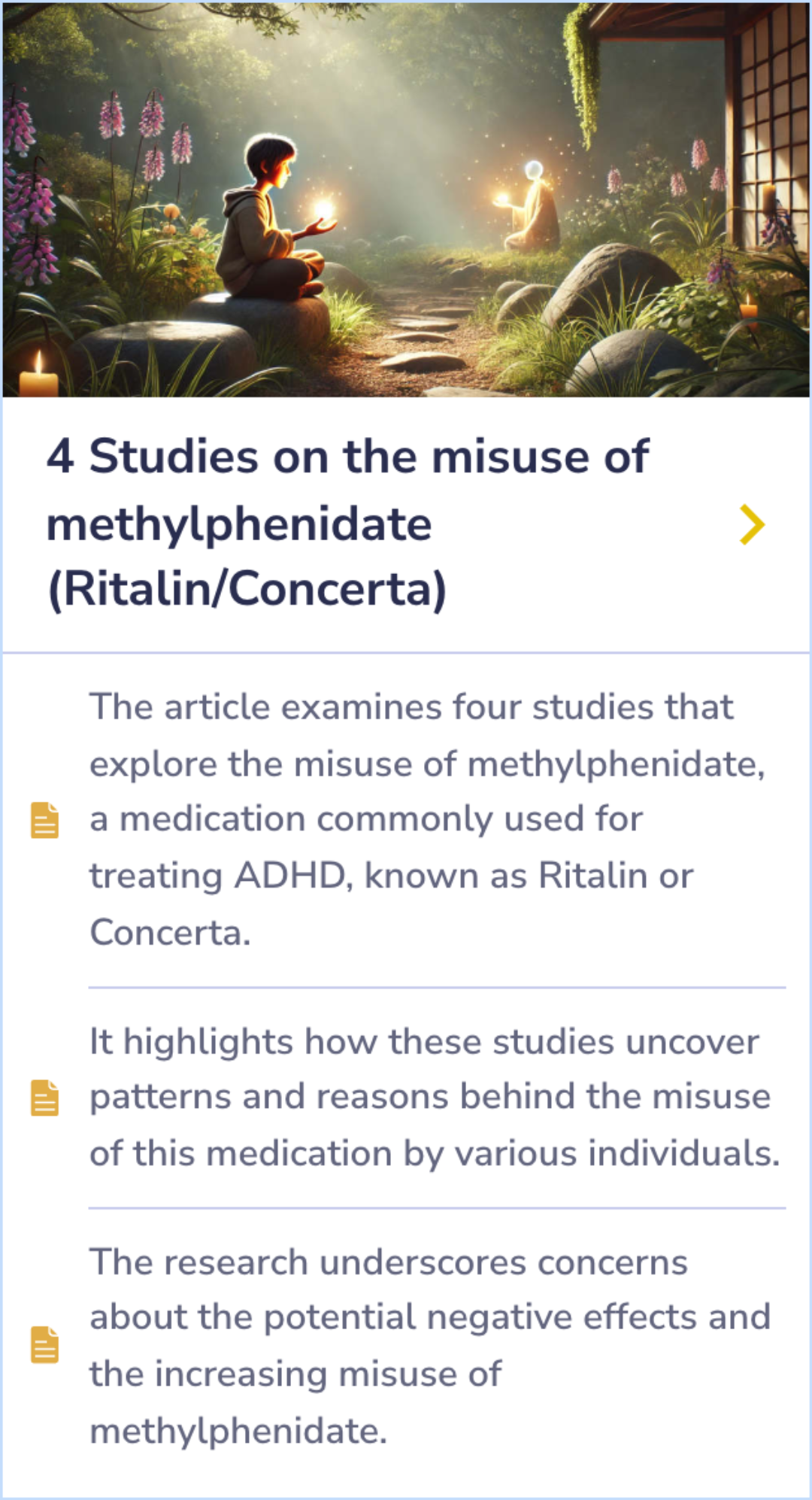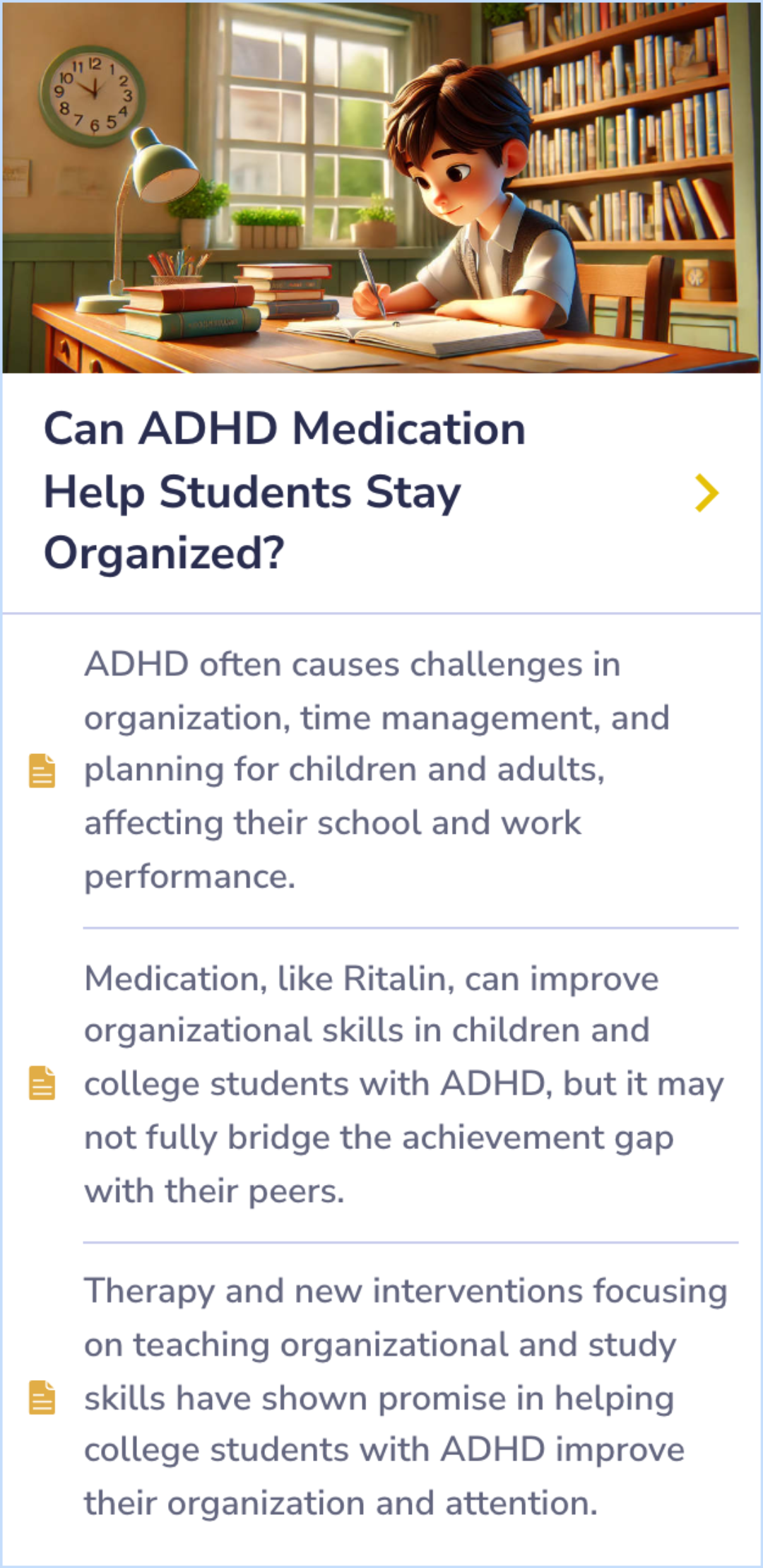Ritalin Paper Database
Visual Abstract
Prevalence of Headache Due to the Use of Methylphenidate: A Systematic Review
Headache Prevalence in Methylphenidate Users
November 4, 2024
author
Santana, L. E. T. S., Ferracioli, P. R. B., Borges, W. R.
journal
Eur J Med Health Res
Date Published
2023
Why link to a visual abstract?
What is a visual abstract?
Original
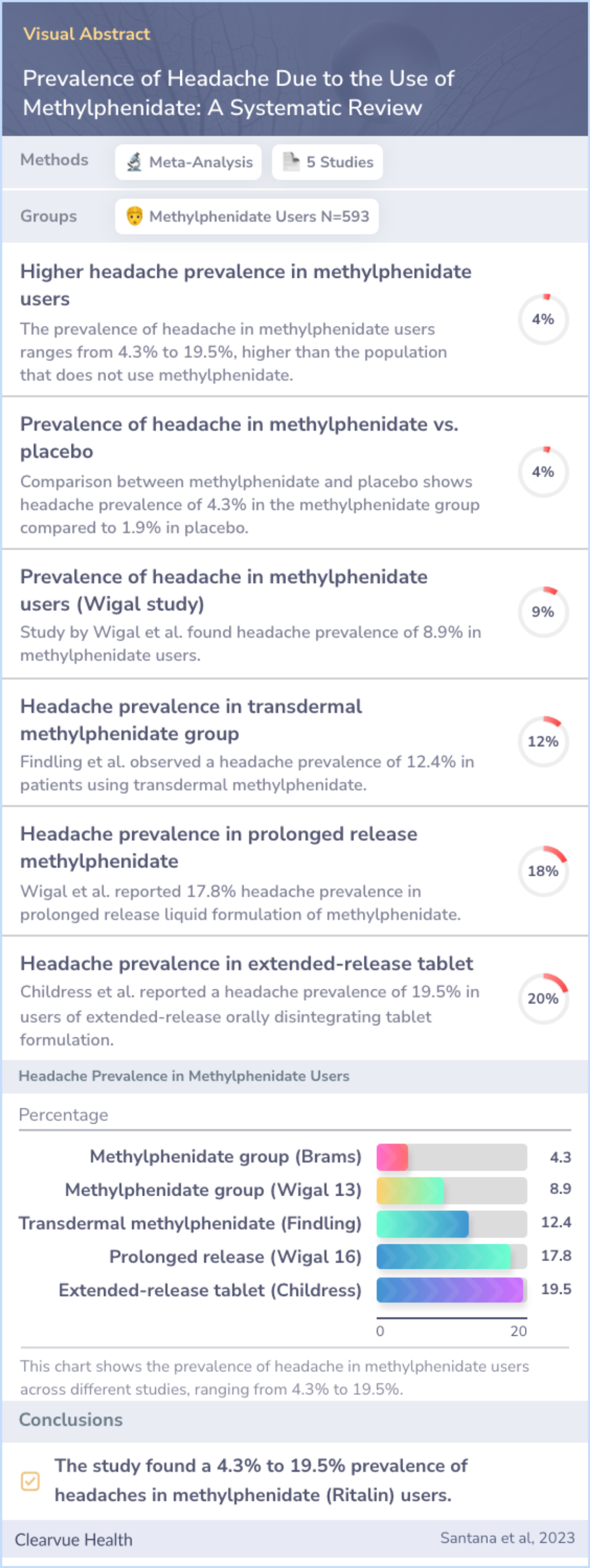
Study Summary
🔬
What They Studied
The study aimed to determine the prevalence of headaches in people using methylphenidate (Ritalin) for ADHD treatment.
💡
What They Found
The study found that the prevalence of headache in methylphenidate users ranged from 4.3% to 19.5%, which is higher than in people who do not use the medication.
📚
What This Means
These findings suggest that headaches are a common side effect of methylphenidate (Ritalin) and should be monitored, aligning with the known risks associated with stimulant ADHD medications, which can include similar side effects.
Study Summary
Study Overview
This study set out to explore the relationship between headaches and the use of methylphenidate, a medication often prescribed for ADHD. Researchers noted that while the drug can help with symptoms of ADHD, it also may lead to headaches, which can affect how well people stick to their treatment plans. In particular, the study found differences in headache prevalence based on the type of medication used and called attention to gaps in previous research.
Ultimately, it emphasized the need for more studies to fully understand headaches linked to methylphenidate, especially in different populations.
Ultimately, it emphasized the need for more studies to fully understand headaches linked to methylphenidate, especially in different populations.
Abstract: background
The aim of this study is to define, through an analysis of the literature, the prevalence of headache in methylphenidate users.

Need for Research
"Given the use of methylphenidate by people with ADHD and by an unknown portion that uses it in a non-prescribed way, we see a need to research and publicize the relationship between headache and methylphenidate, so that it does not become a public health problem, generating greater security and knowledge for doctors who prescribe and comfort and confidence for those who use this medication as prescribed."
Aim of the Study
"The aim of this study is to define, through an analysis of the literature, the prevalence of headache in methylphenidate users."
Challenges in Treatment
"A significant finding is the correlation between methylphenidate formulations and adverse side effects, particularly headache, which poses a challenge for ADHD treatment compliance among users."
Study Summary
Methods
Researchers performed a systematic review by searching scientific databases like PUBMED and SCIELO. They focused on terms such as 'attention deficit disorder with hyperactivity,' 'methylphenidate,' and 'headache.'
Only studies conducted in the last 10 years, involving humans and randomized clinical trials that examined headaches as a side effect of methylphenidate, were included in their analysis.
Only studies conducted in the last 10 years, involving humans and randomized clinical trials that examined headaches as a side effect of methylphenidate, were included in their analysis.
Abstract: methods
A systematic review was conducted with searches on PUBMED and SCIELO. The terms were adapted according to the research platform used, whose combinations involved the following descriptors: ´´attention deficit disorder with hyperactivity``; ´´methylph...more

Study Summary
Results
Out of 44 articles reviewed, five were analyzed, including a total of 593 participants. Most of the participants were male. The findings revealed that headaches occurred in 4.3% to 19.5% of those taking methylphenidate.
This rate is higher compared to individuals not using the drug, suggesting that it is important to monitor and address headache risks associated with methylphenidate use.
This rate is higher compared to individuals not using the drug, suggesting that it is important to monitor and address headache risks associated with methylphenidate use.
Abstract: results
Of the 44 articles identified, five were included for analysis, totaling 593 participants, with a male predominance. The prevalence of headache ranged from 4.3% to 19.5%, higher than the population that does not use methylphenidate, which reinforces ...more
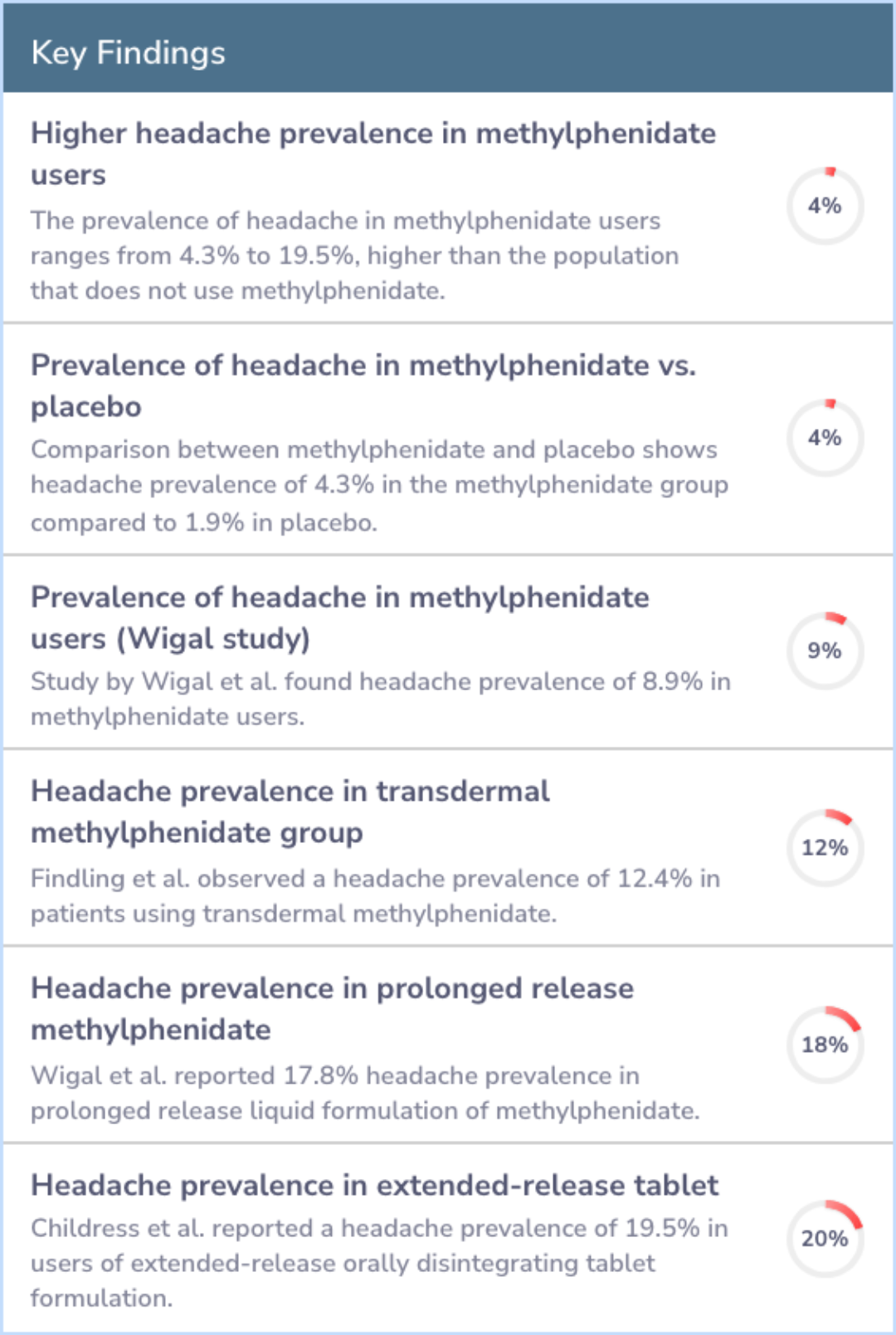
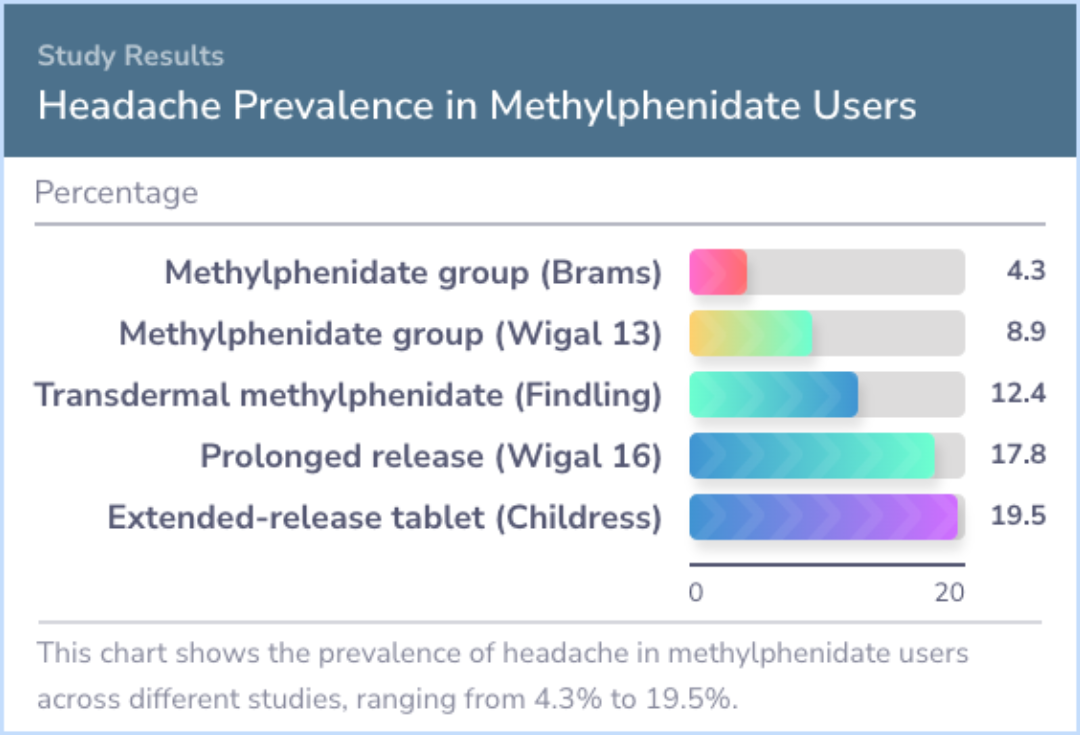
Study Summary
Conclusions
The study highlights that headaches affect between 4.3% to 19.5% of methylphenidate users. Findings suggest the need for more research due to the limited number of studies connecting headaches with methylphenidate.
The occurrence rate of headaches changes based on the specific form of the medication, indicating that further investigation could help in better managing this side effect.
The occurrence rate of headaches changes based on the specific form of the medication, indicating that further investigation could help in better managing this side effect.
Abstract: conclusions
The prevalence of headache resulting from the use of methylphenidate ranged from 4.3% to 19.5%. It is also said that there are few studies that associate headache and methylphenidate. The proportion in which the headache appears in patients using met...more
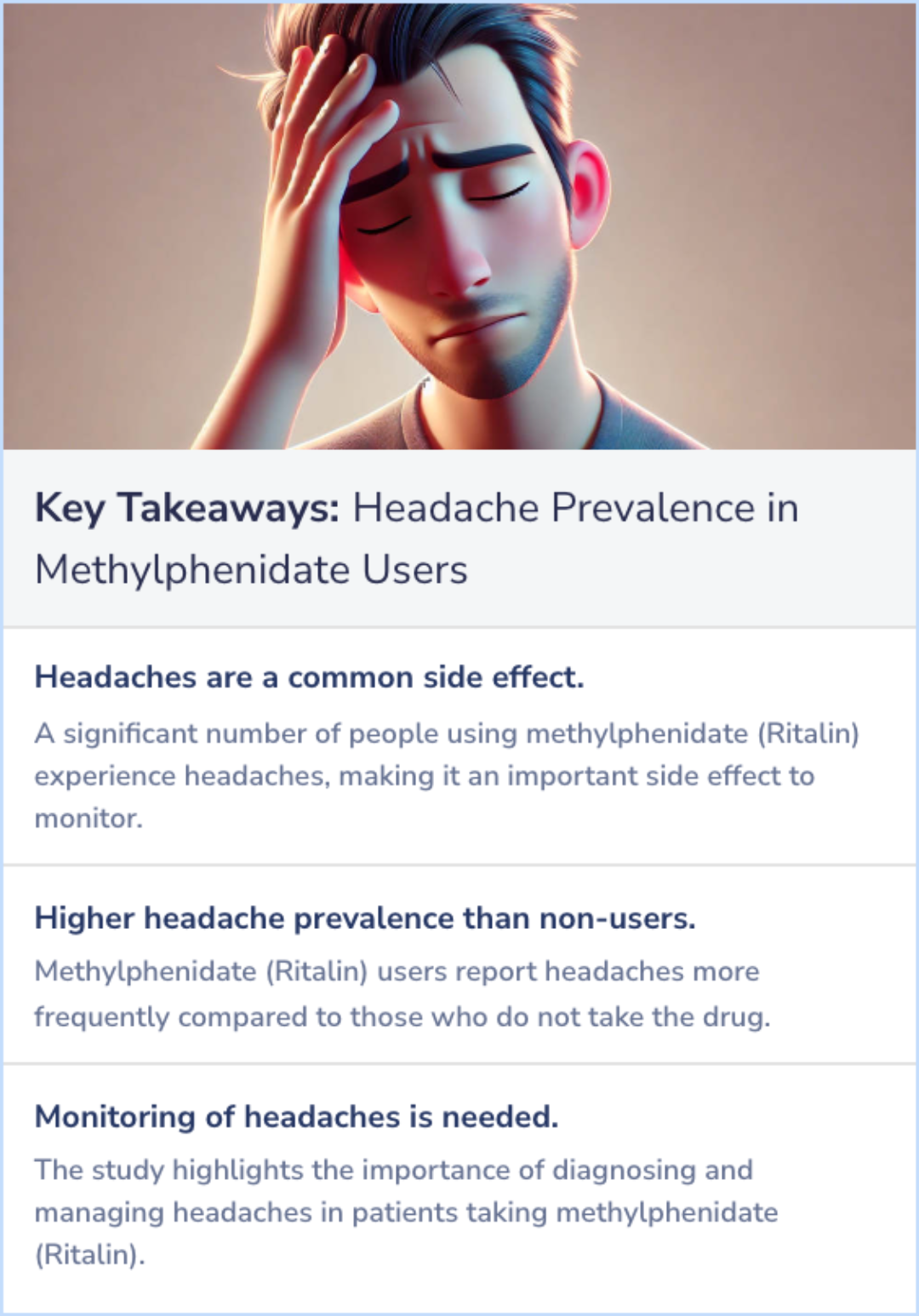
Background Information
Patient Guide
👨⚕️
Methylphenidate Uses
FDA-approved for treating ADHD in adults and children. Also used as a second-line treatment for narcolepsy.
🧠
Mechanism of Action
Acts by blocking reuptake of norepinephrine and dopamine, boosting their levels in the synaptic cleft.
💊
Formulation Variety
Available in various forms: immediate, extended, sustained-release, chewables, and transdermal patches.
👀
Monitoring Guidelines
Regular monitoring for cardiovascular and psychiatric side effects, plus risk of abuse is necessary.
❤️
Cardiovascular Risks
Can worsen heart issues and not recommended for those with severe cardiovascular conditions.

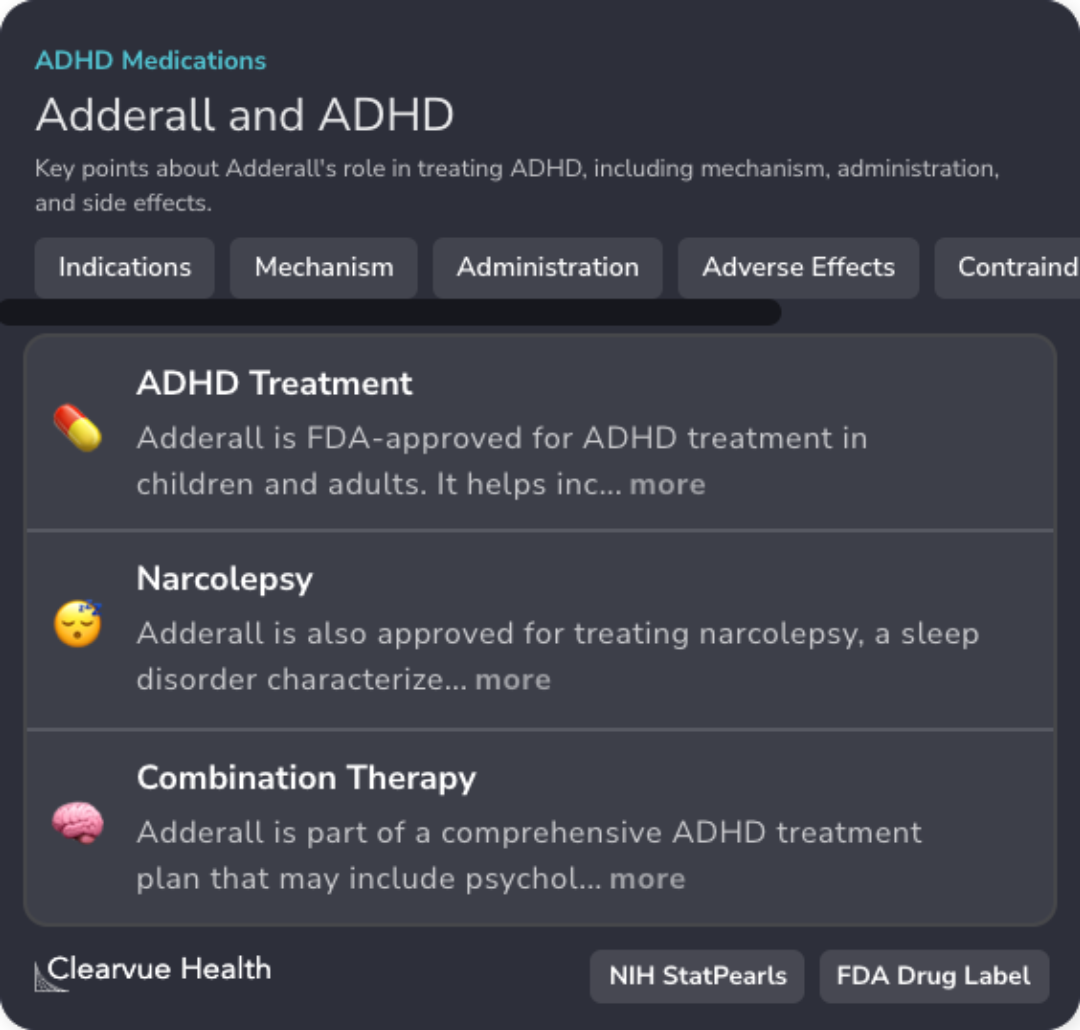
Professional Guide
Expert Opinion: Headache Prevalence in Methylphenidate Users
The findings underscore the notable prevalence of headache in those using methylphenidate for ADHD, aligning with known side effects of stimulant medications like headaches and sleep disturbances.
With methylphenidate as the recommended first-line treatment for young children, recognizing these adverse effects is vital for effective management.
Given the unpredictable individual response to stimulants, monitoring patients for other potential issues, such as cardiovascular effects, is equally advisable.
With methylphenidate as the recommended first-line treatment for young children, recognizing these adverse effects is vital for effective management.
Given the unpredictable individual response to stimulants, monitoring patients for other potential issues, such as cardiovascular effects, is equally advisable.
Evidence Summary
Unpacking Methylphenidate Misuse Patterns
A review of four studies sheds light on the troubling patterns of methylphenidate misuse, which is commonly prescribed for ADHD. It uncovers the various reasons individuals might misuse this medication, revealing insights into user behavior and motivations.
These findings highlight the significant concerns regarding the rising misuse of methylphenidate. The research not only points to the effects of this misuse but also stresses the necessity for greater awareness and improved management strategies for this widely used ADHD treatment.
These findings highlight the significant concerns regarding the rising misuse of methylphenidate. The research not only points to the effects of this misuse but also stresses the necessity for greater awareness and improved management strategies for this widely used ADHD treatment.
Evidence Summary
Improving Organization and Focus for ADHD
ADHD can challenge organization, time management, and planning skills, impacting school and work performance for both children and adults. Ritalin may help, especially with organization, but medication alone might not fully close the achievement gap compared to peers.
Therapy and interventions aimed at teaching study and organizational skills offer additional support, showing promise particularly among college students with ADHD by enhancing their attention and organization.
Therapy and interventions aimed at teaching study and organizational skills offer additional support, showing promise particularly among college students with ADHD by enhancing their attention and organization.
Evidence Summary
Stimulant Use During Pregnancy and Birth Defect Risks
Stimulant use during pregnancy is becoming more common, raising questions about its effects on fetal development. This study explores whether methylphenidate and amphetamines, taken early in pregnancy, are linked to birth defects.
The findings show a slight increase in heart defect risks for infants exposed to methylphenidate but not amphetamines. For major malformations overall, amphetamines show no additional risk, while methylphenidate suggests only a minimal increase.
These results provide a clearer picture of the risks associated with these medications during early pregnancy.
The findings show a slight increase in heart defect risks for infants exposed to methylphenidate but not amphetamines. For major malformations overall, amphetamines show no additional risk, while methylphenidate suggests only a minimal increase.
These results provide a clearer picture of the risks associated with these medications during early pregnancy.

